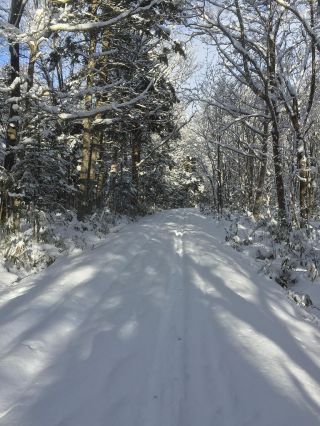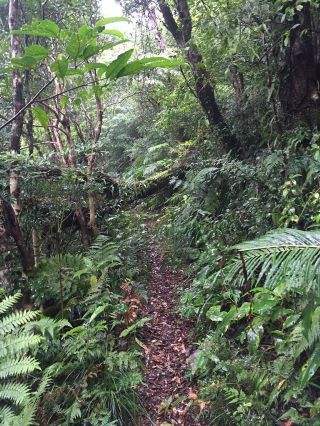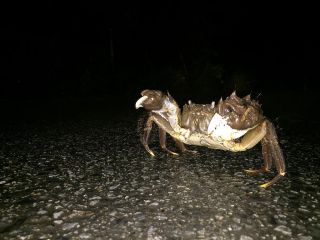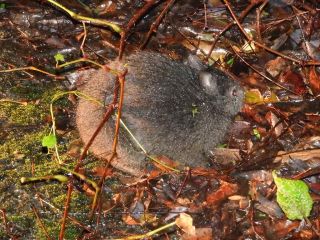Amami Oshima at sunset © Mark Brazil
Amami Night Safari
By Mark Brazil | Jan 31, 2016
After several windless days of hard frosts and heavy snows the forests of Hokkaido, Japan's northern isle, seem overwhelmed with snow. It rims and coats twigs, branches and trunks alike; it has accumulated in the canopy in ribbons, rich clumps, bolsters and heavy pillows until boughs and branches are bowed down beneath the smothering weight. Periodically flexible branches bow so deeply that they shed their white load, if the numbing frost and unrelenting weight don't snap them off first. Then, with an audible whumph, the dead weight of a snow pillow tumbles from a branch like a bursting sack of flour. As it lands it craters the snow layer below, and is followed in its heavy trajectory by a white dust cloud as if part of an explosion. The air fills with snow powder, momentarily obscuring visibility; most descends in a cloud from above, but in an instant it mingles with that blown up and out by the impact. The fine, crystalline mini-avalanche is quickly over, it disperses sideways and fades like fog in strong sunshine; and the softly muffling silence of the snow returns.
This is a northern winter at its best, the forest is a peaceful place, quiet save for the barely audible falling snow, the resonant tapping of foraging woodpeckers, the sibilant contact calls of small forest birds and the ripping, swish-swoosh of my cross-country skis as I break trail. Meanwhile, near the opposite end of the Japanese archipelago winter could hardly be more different. Here there is also a kind of silence, but it is redolent of dampness and humidity, and it brims with the white noise of insects, not with the white noise of falling snow.
As if the fallibility of visual memory was not distressing enough, the memories engendered by other human senses fade inordinately quickly. So visually oriented are we as a species that our vocabulary even lacks sufficient descriptors for the smells and sounds we encounter, much less adjectives to use when recalling and reliving them days or weeks later. How then to describe to you the sounds, and smells, of dampness after winter rain in a subtropical forest, or the varied ripping, burping, rasping and clicking sounds of nocturnal insects and frogs, and the feel of the night time air somehow slightly cool on the skin on a mild sub-tropical night? Even describing the elation felt from being on a hunt at a time when our visual acuity is at its weakest runs into the difficult of conveying sufficiently the strength of personal emotions.
Setting off into the night, a time when our main senses are at their weakest is an adventure. When that adventure has the focus of finding nocturnal wildlife, as on a night safari, then the challenges are enormous, but the rewards are thrilling.
I am a fan of night safaris. Whether in search of elusive endemic fruit bats, glowing green fungi (green pepe), or terrestrially foraging hermit crabs in the Ogasawara Islands, the world's largest, and my favourite nocturnal bird, Blakiston's Fish Owl in its riverine habitat in east Hokkaido, or tree roosting rails and tiny scops owls in Yambaru (northernmost Okinawa), night safaris pose a challenge, provide the thrill of the chase and, on many occasions the elation of exciting and unexpected finds.
The forested hills of Amami Oshima rank among my top four night safari destinations in Japan. Here the main gifts are not mega mammals or monkeys as one might find on a night safari in South America, Africa or South Asia, but there are frequent surprises and delights in smaller packages – surprisingly even more on damp nights after rain!
Driving into the hills along narrow, winding forest roads that are over-arched by enveloping trees, I am reminded of my first impressions during visits in the 1980s and 1990s. I swore that I would never return, so awful and depressing was the forest clearance and the idiotic and devastating introduction of mongoose and other alien predators. The pace of change was too great. However, I was ultimately tempted back again and I was delighted to find that much has indeed changed, but for the better!
Forest clearance is under control, the Mongoose Busters have been hard at work eradicating these devastating introduced predators, and roadside clearance along various hill roads has been halted allowing saplings to grow up, the canopy to close over the roads and so begin to shade out the various non-native sun-loving plants that had begun to colonize into the forests by way of the once exposed and sunny roadsides.
With so much change having taken place in the 30 years or so since I first visited you can imagine my excitement and anticipation on re-meeting and setting off in to the night with local naturalist Tsuneda Mamoru. Tsuneda is a veteran of the conservation movement on Amami Oshima, a dedicated lifelong naturalist and a keen photographer.
One of our first sightings was in fact of an extraordinary forest creature, scuttling across the road – a large endemic land crab, seemingly hairy on its claws; it was soon gone into the deepening darkness of the night. Our initial 2-3 hour plan for our excursion soon stretched to 4-5 hours in our pleasure and distraction at spotting all manner of creatures and their signs, from birds roosting up above to amphibians and reptiles on the ground below. I soon lost count of the number of times we stopped and emerged from his vehicle to approach and examine our reptilian, avian or amphibian finds.
My human, genetically induced fear of all that is serpentine was overwhelmed in an instant by my personally learned fascination with reptiles, especially by the frog hunting snakes of Amami. I recall that in the early 1980s before my first ever visit to Japan's Nansei Shoto my friends warned me about the terrible dangers of Habu (pit vipers). So many and so dire were the warnings I received that I was convinced that I would die of snakebite even before leaving the airport! Rational contemplation helped me realize that with so many people living, and surviving, on Okinawa my chances of snakebite must actually have been infinitesimally small. In fact it took me many trip south to visit Yambaru before I encountered my very first pit viper and it fled so swiftly that I couldn't even take its picture.
Roll the reel of time forwards and I find that I am actually looking forward with anticipation to our first snake – and eventually it is there on the track before us, a Hime Habu Ovophis okinavensis looking a dark, angry reddish-brown, its thick darkly patterned body tightly zigzagged then suddenly tapering to a short thin tail, in all less than a metre in length. Amami's pit vipers are not averse to taking a range of small rodent prey, but they are accomplished frog hunters, and I would not want to be an amphibian in the open when the Hime-Habu is about. We encountered several before we found our first Habu Trimeresurus flavoviridis – what a different creature, so long (nearly one and a half metres), its gently tapering body seeming to flow across the track, and at a deceptive speed; frogs beware!
Our first frog of the night was a gorgeous one, an Amami Green Tree Frog Rhacophorus viridis amamiensis, known here as Amami Aogaeru. It was a beautiful shade of pale, lime-green. It crouched motionless in our torch beam its broadly padded fingers and toes giving away that this creature is equally at home in the vertical plane as it is in the horizontal. Its enormous reflective eyes were like windows into a bizarrely different soul. I could see myself reflected in the pools of those light-swallowing organs, yet somehow the stare returned was benign – I was not on its menu. Then it seemed that each turn of the road revealed yet another amphibian, an Amami Tip-nosed Frog Odorrana amamiensis sitting with its nose appropriately raised in a supercilious pose was but the first of many, then a great olive-skinned creature, an Otton Frog Babina subaspersa, the largest on the island and with a loud deep call like a distant fog horn. My all-time favourite Japanese frog however is somewhat smaller, strikingly patterned and somehow more appealing. The reticulated pattern of black and deep green of the Amami Ishikawa’s Frog Odorrana splendida does not, at first mention, sound attractive, but see one against forest leaf litter and the true beauty of its crypsis is remarkable.
Four frog species down, an array of birds sleeping at roost from bulbuls and turtle doves to Grey-faced Buzzard, and we are still making discoveries. The night is rolling onwards and there is no end to our enthusiasm.
Here and there on the old roadbed of the crumbling forest track I have noticed strange collections. Tsuneda-san disillusions me and confirms that they are not Amami black olives dropped in haste by a surprised olive poacher or abandoned by a striking olive picker. No these are the deposits of an extraordinary endemic mammal. Curved haunch, broad paw, rounded ears, blackish brown pelt mark out the oddly unique nocturnal mammal of Amami.
Like a time bandit, the Amami Black Rabbit Pentalagus furnessi has been marooned in splendid isolation for countless millennia. In that long solitude, it has picked up strange habits, such as living in dense forest and burying its young alive between nightly feeds in order to protect them from predators until they are large enough to go solo.
The island has no squirrels, no foxes, no macaques and no deer, no tanuki, no badgers and no bears; Amami is too far south for those. Biological excitement here lies in the unique, endemic species that have evolved here free from the predation or competition that those more wide-ranging species bring, and the nocturnal, forest-dwelling rabbit is one of the surviving oddities.
A jay, as restricted in its range as the rabbit, and known by the odd eponym Lidth’s (Garrulus lidthi), is huddled asleep on a trackside pole like an excess insulator left behind by an errant lineman. It is colourful by day, yet even the pool of light cast by a strong flashlight renders it only as a pale form against the starless blackness of a cloudy night.
I heard a soft coughing in the night, u-hu, u-hu, repeated several times. The gentle sound was so filtered by trees and night-time noises that it was impossible to locate ‘the phantom that coughed’ or the next, or the next. Finally, and suddenly, a coughing culprit flicked into view, it seemed as if it was pulled out of the night like a marionette on a wire. One moment it was invisible, part of the night, the next it was boldly present and staring at me. A diminutive owl!
An owl, of any size, does not gaze, it stares with a ferocious intensity. Its stare bores through the dampness of a subtropical night as if down a microscope to penetrate the darkness. What does that state perceive? A beetle scuttling? A katydid crawling? An earthworm insinuating its way through damp grass? Or is it just returning my own stare? This tiny bundle of power, as if distilled from darkness itself, is Japan’s smallest owl of all, an Elegant or Ryukyu Scops Owl Otus elegans. Honed and skilled the foci of this bird’s hunting abilities converge in it’s steely tipped talons and it’s sharp curved beak; it swoops through the blackness, descends swiftly, snatches at prey too small for me to recognise, and is gone into the night. The departure of the owl seems to have torn apart the darkness. Our dream world dominated by nature is shattered. In this sundered moment we realise that it is time for us to return to the ‘real world’ – but not for the last time.
I will most certainly return to the exciting forests of Amami one very night soon.
Outro
If you have read this far, then you may enjoy my previous articles, including recent offerings such as “Life at the Water’s Edge” (December 2015), “The Bird that Saved Me from Death” (November 2015), “Crowing about Ireland” (October 2015), “Silk-winged Emperors” (September 2015). These and many more can be found on this website, and on our Facebook page (please do visit and hit the “Like” button).
Author and naturalist Dr Mark Brazil has written his Wild Watch column continuously since April 1982. All Wild Watch articles dating back to 1999 are archived here for your reading pleasure. A collection of Mark’s essays The Nature of Japan and two handy pocket guides The Common and Iconic Birds of Japan and The Common and Iconic Mammals of Japan have been published and are also available from www.japannatureguides.com




















